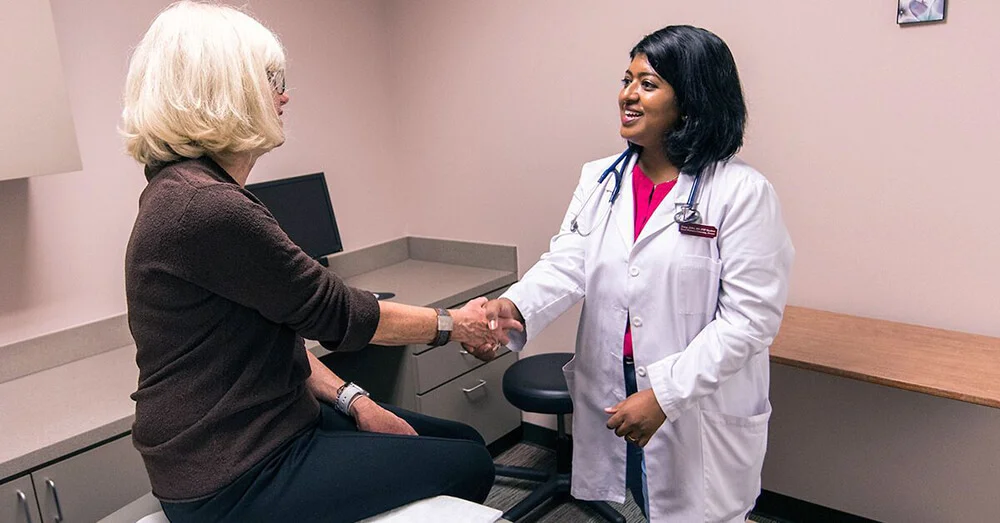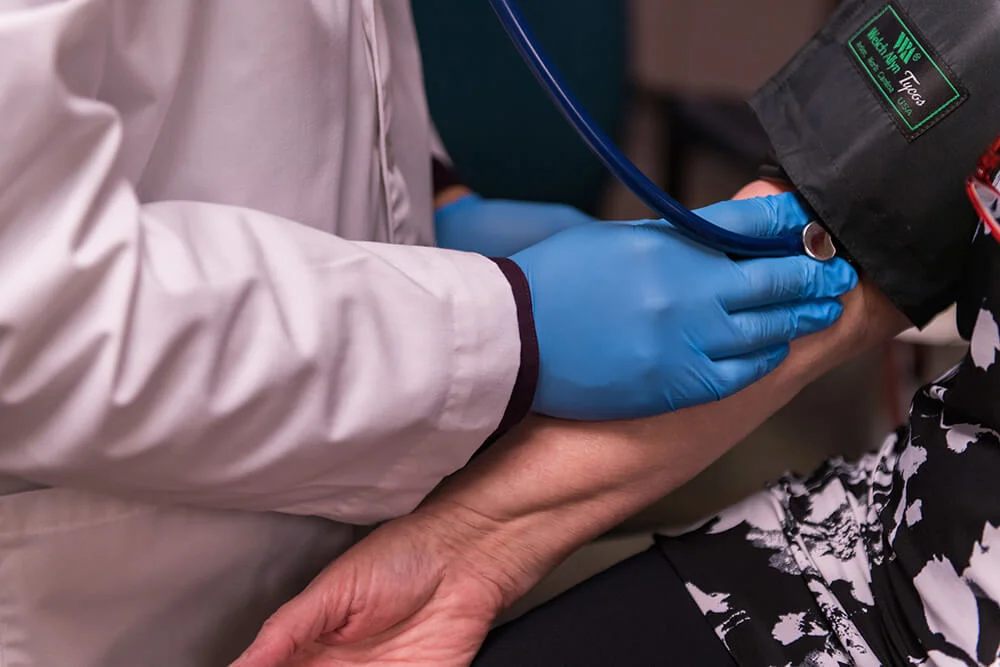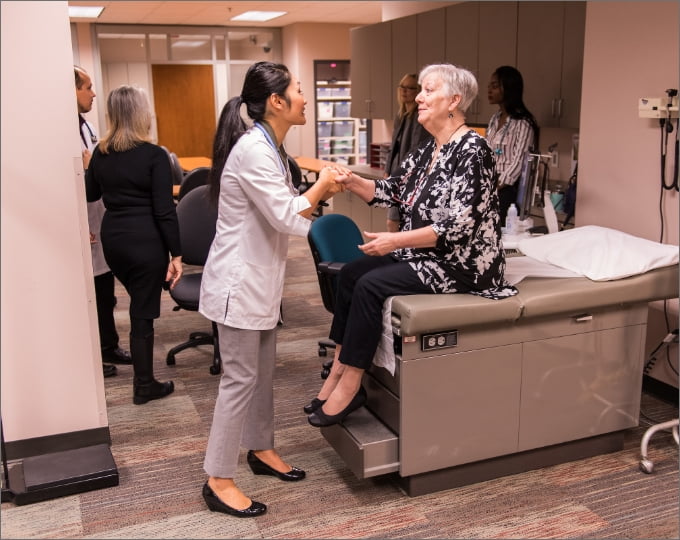
How to Start a Nurse Practitioner Private Practice
October 26, 2020Many aspiring nurse practitioners will research how to start a nurse practitioner private practice. That's because nurse practitioners can enjoy the benefit of working independently.
In the U.S., almost a quarter of nurse practitioners work in private practice. Among them are graduates of the online FNP program at Texas Woman's University, many of whom will open a nurse practitioner private practice of their own.
Use this blog to explore 11 considerations for how to start a nurse practitioner private practice – from securing startup funding to implementing health care technology.
*This blog is not intended to be a substitute for professional legal or financial advice. Consult professional advisors before making any tax, financial planning or legal decisions.

Photo taken pre-COVID; masks were not required.
1. Becoming a Nurse Practitioner
Becoming a nurse practitioner is the first step in how to start a nurse practitioner private practice. You'll need to graduate from a nurse practitioner program like the one at Texas Woman’s University and obtain your national and state credentials.
The process takes between two and four years.
Complete Your Nurse Practitioner Education
Nurse practitioners are advanced practice registered nurses who hold a post-graduate degree in nursing.
If you're a BSN-prepared nurse, then you can obtain a:
- Master's degree
- Doctorate
- Post-master's certificate.
Each path has its advantages. Spend time researching them and decide which one will help you accomplish your career goals.
As you consider which nurse practitioner program to pursue, you'll also need to choose your specialty. Nurse practitioners can specialize in one of several areas, including acute care, pediatric health and family health.
You can open a nurse practitioner private practice in any specialization area, but the U.S. has a particular need for primary care providers.
By 2032, there will be a deficit of up to 55,000 primary care doctors. As a family nurse practitioner, you’ll be equipped to fill the gap by providing primary care to patients of all ages.
Obtaining National Board Certification
Nurse practitioners can work once they've obtained national board certification. You can apply for yours after graduating from an accredited nurse practitioner program.
Two boards offer nurse practitioner credentials in the U.S. – the American Nurses Credentialing Center and American Association of Nurse Practitioners.
Both will require you to submit an application and pass an exam. When you successfully fill all of the requirements, you'll receive a nurse practitioner credential that's valid for five years.
Getting State Certification
Nurse practitioners must be licensed in the state in which they practice. The process for licensure varies across the country.
In most states, you'll need to:
- Complete an application about your nurse practitioner education, certification and professional history.
- Verify your RN licensure.
- Pay a fee.
Once you're a licensed nurse practitioner, you can dive deeper into how to start a nurse practitioner private practice.

2. State Practice Environment
Every state has specific laws and regulations that govern how to start a nurse practitioner private practice. Before you take steps to establish yours, learn about the practice environment where you plan to work.
State practice environments fall into three categories:
- Full practice
- Reduced practice
- Restricted practice
Twenty-one states and the District of Columbia permit full practice authority.
Nurse practitioners can exercise the full scope of their training and work autonomously. That means you can own and operate a nurse practitioner private practice without physician oversight.
The remaining states have reduced or restricted practice environments.
Laws and regulations limit at least one element of practice and/or require nurse practitioners to work under the supervision of a health care provider. These limitations also apply to private practice.
Do you want to start a nurse practitioner private practice in a state with a reduced or restricted practice environment? It's feasible with the guidance of professional advisors who can help you analyze all of the implications.

3. Your Business Plan
Like any small business, a nurse practitioner private practice needs a business plan. It’ll help you structure, operate and grow your practice, secure startup funding and attract staff.
Creating a thorough business plan takes time. So, get started several months before you intend to open your private practice.
According to the U.S. Small Business Administration (SBA), a traditional business plan has a combination of the following nine sections.
Executive Summary
In this section of your business plan, summarize the purpose of your nurse practitioner private practice and explain why it will be successful.
Include your business name, an overview of your services as well as the leadership and employee structure. You can also add high-level financial information if you plan to seek financing.
Company Description
Provide details about your practice, focusing on its strengths. Describe the patient population you'll serve and why your business will have an advantage over competitors.
Market Analysis
Performing a market analysis is vital to distinguish your nurse practitioner private practice. Study competing clinics and what they do well. Then outline how yours will outperform in these areas.
Organization and Management
The business plan should also outline the legal and management structures of your practice.
How will your practice be incorporated (e.g., corporation, partnership, limited liability company)? Who is responsible for what tasks? You can insert an organizational chart and the resumes of key team members.

Services and Products
Discuss all of the services and products your nurse practitioner private practice will offer patients as well as their benefits.
You can only provide the services for which you have certification. For example, family nurse practitioners offer many of the same services as primary care doctors, such as immunizations, school physicals and health maintenance screenings.
This section can also incorporate the pricing structure and acceptable methods of payment, including approved insurance providers.
Marketing
Attracting and retaining patients is critical to the success of your nurse practitioner private practice.
There are dozens of methods for connecting with your clientele – from creating a website and sending e-newsletters to starting a patient referral program.
Outline your marketing budget, tactics and how you'll measure the return on your investment.
Funding Request
Add this section if you need financing to open your nurse practitioner private practice. Investors and lenders will want to know:
- Type of funding you're seeking (e.g., debt or equity)
- Amount of funding you need
- How you'll use the funds
- Terms of financing
- Period the financing will cover
Financial Projections
Financial projections can strengthen your funding requests. Detail your forecasted financial outlook for the next five years, including:
- Projected income
- Balance sheets
- Cash flow statements
- Capital expenditure budgets
Appendix
Put supporting documents in this section, such as credit history, licenses, permits and legal documents.

Photo taken pre-COVID; masks were not required.
4. Startup Funding
From securing a location to hiring employees and purchasing supplies, starting a nurse practitioner private practice requires capital.
You'll have a few options for acquiring financing:
- Self-funding: Funds collected through personal savings, friends or family. This option gives you the greatest control over your nurse practitioner private practice but also comes with significant risk.
- Loans: Money provided by banks and credit unions. Women's Business Centers across the U.S. also offer small business loans. With a loan, you'll retain full control over your practice.
- Small Business Grants: Grants can also help you meet your operating costs. Many organizations offer grants, including the federal government. The Office of Management and Budget administers www.grants.gov, a searchable database of discretionary funding opportunities from federal agencies.
But how much funding will you need? Here's how to find out:
Identify the startup expenses of your nurse practitioner private practice.
New private practices incur many costs. In addition to those listed above, you'll pay fees for licenses, marketing and legal and financial guidance.
Consult with mentors and established practices to determine all of your startup expense categories.
Estimate the cost of each expense category.
Connect with vendors and service providers to find out what each expense category will cost you over the next three to five years.
You'll learn that some categories have more straightforward costs than others.
For example, the charges for permits and licenses are fixed and often published online. Determining employee salary requires more research and personal judgment.
Calculate the total financing you need.
Organize your expense categories into two groups – one-time and regular. Then, add the costs in each group to determine how much funding to secure.

Photo taken pre-COVID; masks were not required.
5. Practice Location
Where will you open your nurse practitioner private practice? Choose wisely – the location will have legal and financial implications.
As you assess various places, consider the following three factors.
Nurse Practitioner Demand
The country needs more nurse practitioners. But according to the U.S. Bureau of Labor Statistics, the demand is particularly high in rural and medically underserved areas.
Contemplate starting your practice in these locations so that you can reach the broadest scope of patients.
Read more about the 10 best places to work as a nurse practitioner.
Regional Expenses
The costs of opening a business differ by region. Variable expenses include property values, business insurance rates, utilities and government licenses and fees.
Payroll will also depend on the location of your nurse practitioner private practice. For example, the average nurse practitioner salary in Abilene, Texas, is approximately $15,000 lower than in Houston, Texas.
State minimum wage laws also vary. A receptionist earning minimum wage in California will make more than in Texas.
Taxes
As a business owner, you'll pay some combination of income tax, sales tax, property tax and corporate tax. All of these will affect your bottom line.
So, research the tax environment of the city, county and state where you want to open your nurse practitioner private practice. You'll discover that certain states are more business-friendly than others.
According to the Tax Foundation, the states with the best and worst business tax climates are:
Top 5 Business-Friendly Tax States:
- Wyoming
- South Dakota
- Alaska
- Florida
- Montana
Bottom 5 Business-Friendly Tax States:
- New Jersey
- New York
- California
- District of Columbia and Connecticut
- Arkansas

6. Choose a Legal Structure
Every business needs to be incorporated with the federal and state governments. Like the location of your nurse practitioner private practice, the legal structure you choose will affect your finances and operations.
There are several types of legal structures. Each comes with unique risks, liabilities, costs, administrative requirements, tax ramifications and benefits.
Depending on where your private practice is located, you can establish the following types of business:
Partnership
A partnership is intended for at least two business owners. There are two kinds:
- Limited Partnerships: One partner has unlimited liability and must pay self-employment taxes. The other partners have limited liability and generally less control over the company.
- Limited Liability Partnerships: Every owner has limited liability, which means the owners are not responsible for each other’s actions.
Limited Liability Company
A limited liability company (LLC) protects a business owner from personal liability in the case of bankruptcy or lawsuits. LLC owners are exempt from corporate taxes but pay self-employment taxes.
Corporation
A corporation is completely separate from its owners, providing the most substantial protection against personal liability.
However, unlike partnerships and LLCs, corporations must pay corporate income tax. Corporations also have high startup costs and require detailed record-keeping.
You can avoid paying corporate taxes by forming a special type of corporation, called an S corp.

7. Obtain Registration, Permits and Licenses
Once you establish a legal structure, it's time to obtain the credentials that'll allow you to open and run your nurse practitioner private practice. At a minimum, you’ll need a federal tax ID number and business registration.
Check with your local government to determine the required credentials for a nurse practitioner private practice.
Tax ID Number
Register with the IRS for a federal tax ID number. You’ll use it to pay federal taxes, hire staff, open a bank account and apply for business licenses and permits.
Some states require businesses to pay income and employment taxes. If this is true where your nurse practitioner private practice is located, register with the state for a separate tax ID number.
Business Registration
Also, register your nurse practitioner private practice as a legal entity with the state or local government where you conduct business. Typically, the secretary of state, business bureau or business agency processes business registrations.
You'll pay a fee and submit an application about your practice.

8. Purchase Malpractice Insurance
Evidence shows that nurse practitioners provide high-quality care, so malpractice rates are low. Only 1.1% of nurse practitioners have been named as the primary defendant in a malpractice case.
Still, the cost of a malpractice lawsuit can be expensive. The average fee for defense is between $20,000 and $40,000. The typical payout for injuries ranges from $200,000 to $320,000, with serious injuries topping $1.5 million.
That's why you need to buy malpractice insurance. It'll protect you and your employees against financial loss from malpractice, errors or negligence.
Like home or auto insurance, malpractice insurance is offered by numerous providers. When picking a provider for your nurse practitioner private practice, research the following:
- Provider's financial stability rating
- Cost of premiums, deductibles and defense
- Terms of the policy
Some states have mandated coverage limits for professional liability insurance, so verify the requirements with your state board of nursing.

9. Source Medical Supplies and Equipment
Your nurse practitioner private practice will need ample medical supplies and equipment. The World Health Organization (WHO) has published a comprehensive guide to managing these items in primary care.
Here's an overview:
Selection
First, determine the supplies and equipment you need and where to obtain them.
The WHO suggests a wide range of items, from basic supplies, such as examination gloves, beds and scissors, to diagnosis tools and sterilizing equipment.
As you make your selections, consider these factors:
- Quality: Choose the level of quality that meets the requirements of your nurse practitioner private practice and the mandated safety standards.
- Cost: Weigh cost versus quality, factoring in the price of taxes, transport, insurance, training and installation.
- Source: Use a manufacturer or supplier that's reputable, licensed and reliable.
- Use and Maintenance: Review the guarantee/warranty of each item to ensure you have sufficient resources to use it, such as water and power.
- Material: Assess whether the items are easy to clean, difficult to break or spoil quickly.
- Reusability: Find out the local policy for using disposable versus reusable equipment. Then, determine which type of item fits the needs of your practice.
After you've estimated your monthly needs, you can project the cost and identify the appropriate suppliers.
Storage and Stock
Determine how you'll organize your supplies and equipment. You'll also need a system for keeping inventory records, so you know when it's time to re-order.
Care and Maintenance
Verify how to clean, disinfect and sterilize all of your items. It's also important to know the procedures for completing routine preventative maintenance.
Disposal
Understand how to collect and dispose of used supplies and when it's time to replace equipment.

Photo taken pre-COVID; masks were not required.
10. Determine Staffing Needs
A successful nurse practitioner private practice depends partly on the team that staffs it.
Your nurse practitioner private practice will need several employees. You'll hire nurses, a phlebotomist, receptionist, accountant and office manager. You might also consider employing additional nurse practitioners, medical assistants, a sonographer or care coordinator.
For each position, write a job description, research the salary standards and develop a benefits package. It'll also be helpful to create an organizational chart, which shows the reporting relationships between employees.
Designing a staff development program is also crucial. Think about implementing orientation training, cross-functional training, continuing education and mentoring.
By investing in staff development, you'll boost:
- Employee retention
- Staff morale
- Practice efficiency
- Job competency
- Patient satisfaction

11. Implement Health Care Technology
Health care technology will help your nurse practitioner private practice deliver high-quality patient care and run efficiently. Explore the available options and decide which tools will help you achieve your goals.
Also, consider the cost, required training and availability of technical assistance.
Many private practices have:
- Scheduling Software: Maintains patient appointments and sends reminders.
- Human Resources Portal: Houses employee information, such as tax forms and the documentation of policies and procedures.
- Electronic Health Records: Collects patient data and performs a population-level analysis. The American Academy of Nurse Practitioners has implementation resources for small practices.
- Decision Support Systems: Enhances quality improvement by helping providers implement evidence-based care.
- Health Information Exchange: Makes medical information easily accessible to patients, such as lab and test results, medications and immunization records.

Get More Information
Now that you know how to start a nurse practitioner private practice, are you ready to begin your journey to becoming a nurse practitioner?
Texas Woman's University offers an online Master of Science in Nursing – Family Nurse Practitioner (MSN-FNP) program that is well-regarded and highly ranked while still being one of the more affordable options.
It will give you the skills to be a holistic primary care provider. You'll develop the health care knowledge, professional behavior and clinical mastery to serve as a family nurse practitioner in a variety of work settings, including private practice.
Ninety-two percent of our graduates pass the FNP licensure exam on their first attempt. So, you'll be ready to start making a difference right away after graduation.

